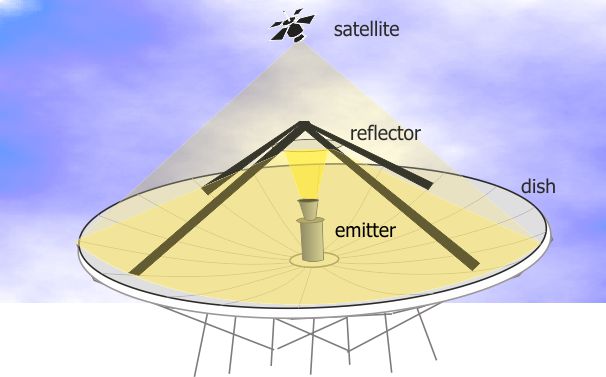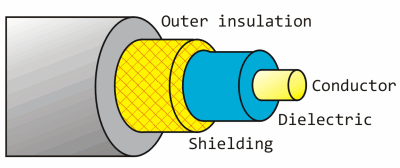Freesat reception - all about dishes
 Brian Butterworth published on UK Free TV
Brian Butterworth published on UK Free TV Satellite reception has both advantages and disadvantages compare with terrestrial (aerial) reception.
By using much higher frequencies (gigahertz, compared to terrestrial televisions megahertz) more transmission channels called transponders (the satellite equivalent of multiplexes) can be provided. For example, there are only six Freeview multiplexes, but Sky or Freesat users can access two hundred satellite transponders.
Aside from exceptional weather conditions (very heavy rain for example) digital satellite provides stable pictures and audio. Where Freeview transmitters are no more than 732 metres above sea level, the geostationary satellites used for television are 35,800,000 metres above the equator so reception is possible even where buildings, trees and hills make terrestrial reception impossible.

The downside of the transmitters being 22,300 miles up in the air is that the signals are very, very weak - so standard TV aerial is of little use. When the signals are sent to the satellites, huge dish transmitters are used to uplink the signal to the satellite. These are tens of metres from side to side, and feature an emitter that generates the signal, which is first bounced of a mirror (called a reflector) and then off the surface of the parabolic dish.

There are many satellites in the sky over the equator. Often these are in clusters over a particular position, for example there are four used for UK television are at 28.2 degrees east. There is another cluster over the 19.2 degrees east positions that are used for German television.
To receive these very weak signals from the satellite, it is necessary to use a dish for reception too. By using a reflective dish, this concentrates the signals onto a small device called a LNB. This is held in front of the dish by a metal arm.

The size of dish for reception is typically much smaller; often 60cm to 100cm in diameter, but the exact size depends upon the transmitting satellite transponder. To keep the transmission power levels down to levels that can be powered by the satellite's solar panels, each beam is focused on a particular area of the Earth's surface. If you are trying to receive the signal at the centre of this zone, a small dish is required. At the outer edges, you may need a 5 metre dish. Maps of these zones are provided by the satellite companies, and are called satellite footprints.
When the dish is installed it must be aligned carefully as the signal is very weak. The installer needs to know the inclination and the azimuth from the ground location to the satellite. If you install yourself you will find that there are markings on the dish that are used to point the dish in the correct position. It is important that the view of the satellite will not be blocked, so must take into account leaves growing on trees and potential building works.
For many people the LNB will have a single cable connected to it, however if you have Sky+ or a multi-room installation the LNB package will actually contain four receivers a quad-LNB. Unlike terrestrial television where you can split the aerial cable to feed more than one Freeview box or television set, with satelite reception you cannot. So, a Sky+ box with two receivers (so you can watch one thing and record another) has two cables connecting the box to the dish.
The cable that connects the dish to the receiver must be satellite grade cable. Whilst this looks superficially like the cable used to connect and aerial to a television, a higher grade cable is required for satellite reception.
Here is an image of a co-axial cable. This sort of cable is used to connect any type of receiving aerial to the reception equipment.

RG6, PF100 and PH100 are all types of coax cable that are suitable for the very weak signals that are received by a satellite dish. (The power is the same as you would receive from a one-bar electric heater on the moon).
The conductor in the centre passes the signals received from the dish to the set-top box. This is made from steel in RG6 cable, and from copper in the RF100 and PH100 types. This makes RG6 less suitable in the UK where rain can damage the cable.
The shielding is responsible for keeping unwanted external interference from damaging the signal. In the cheaper cable this will be a foil wrap, in better specified cables this is a braid (or mesh) of copper wires. The sheild in the RF100 covers 58% of the cable.
The non-conducting layer between the shield and the conductor is called the dielectric. This can be either a solid (RG6), foam (RF100) or air-spaced (PH100) dielectric. This makes the cables progressively more flexible (ie bendy without damage).
7:37 AM
I have a sony HD tv which is already fitted with digital freeview, however I now want to have fitted freesat plus what do I need to do ( I don't have a satellite dish fitted yet)and will my tv be compatible?
| link to this comment |
10:01 AM
Hi,
I have just changed to a free sat recorder however my sat dish has only one cable coming in.
Can i change this to a twin or have i got to change the whole dish aswell ???.
hopefully not as im renting.
Thanks in advance.
| link to this comment |
8:44 PM
hey Hadleigh
1st its silly but sky use a twin core cable for there installs it may look like one cable coming in but maybe 2.
(its worth a look)
2nd take a look at the sky dish has it only got one port on it.
if you do only have one port just call a local company, and tell them you need a quad lnb fitted and a twin cable run.
tell them the rough distance of the cable run and you should be able to get an exact price over the phone not an estimate. (important)
3rd i would suggest when you consider getting it done having the original cable run replaced at the same time.
it only has a limited life span and will cost you an extra call out should there be a problem with it in the future.
i.e
water in cable
animal bite
or any other number of reasons
best of luck
ian 123 aerials oxford
| link to this comment |
11:01 AM
Hi - we have just purchased Humax Fox Sat box to replace sky+ - we used to be able to run 3 other tv's with the same channels but now we can't with freesat - can anyone advise what we can do to get the channels back on the other tv's with limited cost? or is it just bnot possible to run more than 1 tele from freesat box?
| link to this comment |
12:10 PM
Zena - The most cost effective way is to purchase ab RF modulator kit from Amazon Maplins etc. You connect this to the scart connection on the Humax and the RF outs as per how you had with you SKY system. These kits are relatively inexpensive with several manufacturers.
| link to this comment |
10:53 AM
I have a satellite dish would it work with freesat
would I need different conecter to fit the freesat box
| link to this comment |
11:32 AM
John - If the dish is serviceable and is presently aligned to the cluster of satellites at 28degrees South East, then yes. Assuming the wiring is into your property and the LNB (that's it on the end of the dish boom arm)is working Ok, Then it's simply a case of connecting to a "Feeesat" receiver and tunimg in.
| link to this comment |
4:54 PM
i live i norfolk & am looking to buy my own freesat dish/cable & install what type/make should i buy? also can freesat be used in southern crete?
| link to this comment |
Hi les & zena,
I triax tri link box will provide a modulator & tv link function to any freesat / freeview / dvd player etc that it is connected to, here is a link to some info.
http://www.hypex.co.uk/fi….pdf
Mark Aberfan Aerials
| link to this comment |
7:03 PM
I have a Ross Freesat box and Satellite that I have installed myself.
I can pick up the majority of programs but some programs, e.g. DAVE, BBC3 are not listed.
Could you suggest a possible cause for this?
| link to this comment |